

|

Remembering The Day Something Wicked This Way Came.
By Stacey Richter
NOW THAT IT'S all over, now that the menace to our town
has long been slaughtered and the principals are either dead or
married, it's easy to look back on the event of that autumn and
say it wasn't really all that traumatic. But it's important to
remember, as part of our cultural heritage, that at the time the
entire metropolitan area of Tucson was immobilized by terror.
School children were kept home. Buses stopped running. The eye
of the nation was focused on the strip of Fourth Avenue between
Sixth Street and the Toole Avenue underpass. This was once a lively
street teaming with commerce. But on November 14, 1998, it was
reduced to a paste of rubble and ash, glazed with foul-smelling
saliva.
 Some of us will never forget. Others among us are too young to
remember the events of that warm and breezy Saturday afternoon.
Certain youthful types around town have expressed skepticism that
the event even occurred! Their elders find this hard to take,
particularly from snot-nosed punks who like to ride the Trolley
down to the former Fourth Avenue and frolic in the artificial
ocean--an artificial ocean we voted to install in the gaping
crater created in the horrible aftermath of that terrifying day.
Some of us can't even dip a toe in the wave pool without flashing
back to the afternoon when Tab Whiteman's face broke into our
regular programming, disturbing our calm and climate-controlled
lives, to give us the shocking news.
Some of us will never forget. Others among us are too young to
remember the events of that warm and breezy Saturday afternoon.
Certain youthful types around town have expressed skepticism that
the event even occurred! Their elders find this hard to take,
particularly from snot-nosed punks who like to ride the Trolley
down to the former Fourth Avenue and frolic in the artificial
ocean--an artificial ocean we voted to install in the gaping
crater created in the horrible aftermath of that terrifying day.
Some of us can't even dip a toe in the wave pool without flashing
back to the afternoon when Tab Whiteman's face broke into our
regular programming, disturbing our calm and climate-controlled
lives, to give us the shocking news.
Now, Tab: Tab was a weatherman and not a very good one at that.
You kids who know him only from his equestrian statue in Reid
Park may be under the impression that he was always a strong,
charismatic leader (and a skilled horseman), but the truth is
that before the event, Tab was known as a wimpy, blow-dried weather
air-head. It was obvious that he got the job because of his jaw-line,
but despite his regular, Nordic features, Tab couldn't could get
a date. A lot of the women who turned him down expressed their
regrets later. A court reporter was quoted in a magazine as saying,
"Had I known about Tab's inner reserves of strength, I would
have accepted his offer to play miniature golf. But at the time
he just creeped me out. He reminded me of Keanu Reeves on Thorazine."
Tab couldn't even get the weather right, which was why he was
on location that day, reporting that the Fourth Avenue Street
Fair would in all likelihood be blighted by rain and probably
hailstones, though any housecat could see the day was sunny and
clear. It was almost as though Tab was so focused on his instruments
and weather maps that he couldn't believe his own eyes--this was
his fatal flaw, but it was a flaw he overcame spectacularly when
the moment called for it. Just before the event, as you recall
(pay attention, you youthful ingrates), Tab was standing in a
flood of sunlight, his blond hair lit up impossibly bright on
camera, pathetically warning us about impending precipitation.
Behind him shoppers milled, starved for giftware, plodding in
circles through the handicraft booths; it seemed more than a few
of them wore funny hats. Tab finished his report. And that was
that.
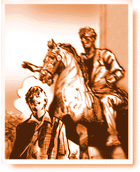 Except for the rumbling. It was as though a monster truck rally
was taking place just off camera, and many viewers assumed it
was some sort of macho entertainment connected with the Street
Fair. Of course, we know now that it was no such thing; we know
it was the unholy, parturient stirrings of a wicked being. According
to the archives, at that time Della Viramontes was just leaving
the downtown café where she worked as a waitress. She had
changed into her street clothes and was walking home, taking the
long way to the west of Fourth Avenue because, and I quote The
Arizona Daily Star here: "I'd do anything to avoid that
greasy street fair. It made me sick to see my neighborhood
taken over by mimes, smelly food booths and tacky merchandise."
Except for the rumbling. It was as though a monster truck rally
was taking place just off camera, and many viewers assumed it
was some sort of macho entertainment connected with the Street
Fair. Of course, we know now that it was no such thing; we know
it was the unholy, parturient stirrings of a wicked being. According
to the archives, at that time Della Viramontes was just leaving
the downtown café where she worked as a waitress. She had
changed into her street clothes and was walking home, taking the
long way to the west of Fourth Avenue because, and I quote The
Arizona Daily Star here: "I'd do anything to avoid that
greasy street fair. It made me sick to see my neighborhood
taken over by mimes, smelly food booths and tacky merchandise."
Those of you who know Della only from her statue in front of
City Hall may be under the impression that she was a rock musician
and a waitress without ambition (part of the "Slacker Army"
that commandeered the carriages), but in truth she was an accomplished
and intelligent young woman who was studying Materials Science
at the University and only played in a rock band on weekends when
she didn't have a paper due. The electric guitar and the bronze
tray of food are meant symbolically; to honor the Army and the
woman who led it, but there was far more to her than any symbol
could summarize. As, of course, the events made abundantly clear.
THE CONFUSION BEGAN at 1:11 in the afternoon. The witnesses
who survived the attack reported that the rumbling grew so intense
that windows began to vibrate and shatter in the nearby West University
neighborhood. Then a shadow fell across Fourth Avenue, occluding
shoppers and booths and a legion of folksy, handmade craft items:
titanium wind chimes, cactus-shaped mailbox stands, Mexican-style
berets, beads fashioned by rainforest tribes from animal dung,
aromatherapy potholders, etc. The air grew humid. There were reports
of a smell--like the odor of hands after grasping live fish. And
then, with a slurp, it was gone--the entire Street Fair: booths,
shoppers, storefronts, cars--they were all just gone. Excised.
And in the absence, a steaming, glistening pit, coated with lime-colored
slime.
Down within the hole, a thing of evil crouched.
The confusion that reiged was reflected by the news coverage
of the event. The first flash from the local affiliate focused
on a series of noise complaints from the nearby West University
neighborhood. The national news coverage was more effective but,
it is agreed now, they lacked the experience and knowledge of
local wildlife necessary for effective identification of the creature.
We remember Dan Rather on the evening news, solemnly reporting
from his desk in New York that "a calamity of unknown nature
has befallen the sleepy town of Tucson, Arizona." He went
on to report that "A giant creature, probably reptilian,
has caused extensive property damage and loss of life with razor-like
precision to a limited portion of this quaint desert town."
There was some grainy, aerial footage of the beast (nobody wanted
to get too close), hunkered down in the pit, motionless and apparently
drowsy from its enormous meal.
 Of course, we were stunned. It seemed that everyone knew somebody
who was shopping at the Street Fair that day, or had intended
to stop by. It was the uncertainty that was so unraveling, the
anticipation of grief that was so painful, even before the shattering
details had been divulged. In those moments we were desperate
to know what had happened; we had to know--for, as difficult
as it was to bear our losses, it was even more difficult to face
an unknown monster. It was like discovering the goblins from our
childhood closets had gained the ability to walk and move and
scratch behind the ears. And to eat.
Of course, we were stunned. It seemed that everyone knew somebody
who was shopping at the Street Fair that day, or had intended
to stop by. It was the uncertainty that was so unraveling, the
anticipation of grief that was so painful, even before the shattering
details had been divulged. In those moments we were desperate
to know what had happened; we had to know--for, as difficult
as it was to bear our losses, it was even more difficult to face
an unknown monster. It was like discovering the goblins from our
childhood closets had gained the ability to walk and move and
scratch behind the ears. And to eat.
The area around the crater had been cordoned off with those thick,
velvet ropes used to keep customers in line at banks--no one knew
why, exactly, except that it was being handled by the Tucson Police
Department, who greeted the event with incredulity. The local
news showed the cordons, and we hoped they would show the beast
and explain the destruction as well; surely, we thought, they
would be able to fill in the gaps the national media had so unfortunately
missed. But what greeted us when we turned on our televisions
only increased our confusion.
When our regular anchorwoman began the broadcast, we realized
something strange was occurring. "A local calamity spawns
nation-wide news coverage for Tucson!" began the anchorwoman;
and then, as the videotapes have shown, she continued to report
on the manner in which the networks had covered the event: "Dan
Rather led the Evening News tonight with the story of chaos and
destruction at the Fourth Avenue Street Fair," she continued,
beaming brightly. She went on to describe exactly how the event
had garnered the attention of the networks. They showed a clip
of the report Dan Rather had just delivered minutes before, and
offered no new information.
That was when the panic began. As a community we felt helpless,
and lost. We just wanted the events described so that they could
be understood and contained. I know some of you young punks think
this is all a big joke, and that you're indestructible, and that
nothing could ever go so wrong that you would suddenly find yourself
living in an world made dangerous and unrecognizable. But lest
you forget: it can happen. It happened in 1998. It could happen
again.
Out of sheer habit, or so it seemed, when it came time for the
weather the news dutifully shifted us to Tab Whiteman. He stood
at the lip of the crater with a blanched face. Tab had seen it
all--we didn't know this. We knew Tab as the butt of jokes, as
the weatherman who reported sunny skies while it was actually
raining. But on that day Tab overcame all that. He used his
eyes. He opened his mouth.
"There's been rain predicted here at the street fair all
afternoon..." Tab looked at the camera, rumpled and upset.
"The weather, I mean. Shit. The weather doesn't matter today
folks. Let's just tell the truth about this. Incredible as it
sounds, a carved wooden gecko came to life, swelled to gigantic
proportions, then went on a bloody rampage and actually ate
Fourth Avenue! Fourth Avenue is gone. Because it has been eaten."
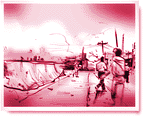 EATEN! OF COURSE, kids today have never seen a crafts fair
gecko--naturally they were outlawed after the event. But those
of you who were alive then may remember the proliferation of these
"cute" ornaments, usually three-dimensional wooden or
metal cut-outs, vaguely lizard-shaped, intended to be hung on
an exterior wall for purely, and dubious, aesthetic reasons. Real
geckos are small, lizard-like creatures with the cunning ability
to cling to a variety of surfaces, including glass; crafts fair
geckos were large, lizard-shaped handicrafts that had to be nailed
to the wall. Later (much later), it was discovered that the monstrous,
engorged gecko that ate Fourth Avenue was larger than its handmade
prototype to the same degree that a decorative wall gecko is larger
than the average real gecko, a ratio of approximately 200:1.
EATEN! OF COURSE, kids today have never seen a crafts fair
gecko--naturally they were outlawed after the event. But those
of you who were alive then may remember the proliferation of these
"cute" ornaments, usually three-dimensional wooden or
metal cut-outs, vaguely lizard-shaped, intended to be hung on
an exterior wall for purely, and dubious, aesthetic reasons. Real
geckos are small, lizard-like creatures with the cunning ability
to cling to a variety of surfaces, including glass; crafts fair
geckos were large, lizard-shaped handicrafts that had to be nailed
to the wall. Later (much later), it was discovered that the monstrous,
engorged gecko that ate Fourth Avenue was larger than its handmade
prototype to the same degree that a decorative wall gecko is larger
than the average real gecko, a ratio of approximately 200:1.
Science has yet to account for this fact.
Or for any of the events of that Saturday, for that matter.
The response of the community was phenomenal, and quite weird.
Almost immediately the area surrounding the former Fourth Avenue
was thronged with thrill seekers and the curious. Bizarre as it
sounds, the area took on an almost carnival-like atmosphere, but
more desperate, wilder. Some combination of excitement and grief,
the heady knowledge that an unearthly, vicious creature lurked
in our humble hamlet--perhaps heralding the end of time--inflamed
the city's youth. Tipsy college boys and girls in single-gender
packs roamed the area, drinking from open containers and setting
off firecrackers. They climbed on one-another's shoulders, hooting,
and straining to get a glimpse of the thing in the hole. Girls
took off their shirts and waved them around like flags. Boys mooned
each other. One group flipped over a car and smeared themselves
with transmission fluid. Panhandlers set up shop at the crater's
edge.
Della Viramontes, quite by accident, found herself among the
revelers. She, too, had witnessed the catastrophe, and I'm sad
to say, the contents of her own apartment were at that exact time
being boiled into a foul-smelling salsa inside the belly of the
creature. Confused and grief-stricken, she wandered for a while,
trying to figure out what to do. Now, I'm sure all of us believe
in our capacity to act sensibly in the face of adversity or indeed,
in the face of pure evil, which is what some have theorized the
giant gecko embodied. (Others say she was God, but this has been
vehemently denied by nearly all organized religious groups.) But
the fact of the matter was, when faced with such a large and disorienting
emergency, most individuals feel an intense sense of powerlessness.
They feel insignificant. They believe the authorities will respond
promptly. The nature of this catastrophe was so singular, however,
that most of the agencies who might have dealt with it--the fire
and police departments, the National Guard, Game and Fish--treated
the disaster with disbelief. It was like a science fiction movie
from the 1950s--the authorities didn't act, because they simply
couldn't believe the reports they were hearing were true. They
were embarrassed. They believed themselves the victims of a prank.
Della, though, was a fast-thinking young woman who wasn't afraid
to take matters into her own hands. She also had an assortment
of geckos living on her front porch. They came out at night, walking
upside-down, arranging themselves in a loose circle around the
porch light. Della spent many evenings just sitting in an old
recliner, watching the geckos stalk and eat the bugs attracted
by the bulb. From these observations she knew that a hunting gecko
will remain very still, essentially frozen, until a particularly
tasty looking treat moves into range. It is then that it strikes.
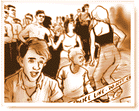 What worried Della were the groups of revelers partying on the
edge of the crater. They shook up cans of beer and did the Macarena
in the spray. They played hackey sack in the rubble. They started
making out. They reminded her of insects, actually, in the way
they moved, so frantic--almost fluttering--well, she wasn't convinced
that the monster was actually sleeping. She thought the monster
might really be hunting.
What worried Della were the groups of revelers partying on the
edge of the crater. They shook up cans of beer and did the Macarena
in the spray. They played hackey sack in the rubble. They started
making out. They reminded her of insects, actually, in the way
they moved, so frantic--almost fluttering--well, she wasn't convinced
that the monster was actually sleeping. She thought the monster
might really be hunting.
Of course, history has borne out this conclusion. The women of
Delta Phi have a beautiful memorial garden dedicated to the sisters
who were eaten that afternoon. They have planted a lovely lilac
tree for each girl--and truly, their deaths were not in
vain. The five girls were picked off one by, "like bon bons,"
Della said, "the kind with alcohol in them," by the
forked and caustic tongue of the giant gecko.
"But that's how I got the idea to use the horse and buggies,"
Della told the Daily Wildcat. "I saw how attracted
the gecko was to warm, prancing, agitated bodies. When that enormous,
green head came up out of the pit, covered with a crust of dirt
and slime, and slurped down those poor women, I came up with the
idea of creating a diversion. I thought horses and buggies would
be better than people, though."
IT WAS WHILE she was making her way south, towards downtown,
that Della came across Tab Whiteman. Tab has lost his habitual
air of distraction. Like Della, Tab was a man who came into his
own during an emergency. He was calmly but firmly warning sightseers
away from the edge of the pit, while explaining the nature of
the danger. For years, Tab had been futilely dealing with the
future--predicting what would happen--while all along his
talent lay in managing a crisis in the present.
"There's a dangerous, giant gecko loose, folks," he
said, "Please step back. Step WAY back. Killer gecko. Ma'am,
do you really want to bring your baby here?"
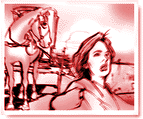 His face was flushed and his sandy hair has broken free of its
dorky, hair-sprayed style. When Della saw him she recognized something--a
can-do spirit, a competence--and there was something else, too.
Something she liked about his eyes, even though she had always
found his weather reports annoying and insipid. Later, she said
she just knew that together, they could destroy this thing.
His face was flushed and his sandy hair has broken free of its
dorky, hair-sprayed style. When Della saw him she recognized something--a
can-do spirit, a competence--and there was something else, too.
Something she liked about his eyes, even though she had always
found his weather reports annoying and insipid. Later, she said
she just knew that together, they could destroy this thing.
Tab recognized a kindred spirit in Della too. Rather than shooing
her away, he let himself be led aside, where Della whispered her
plan into his ear. It only took a moment. But it was a moment
that changed Tucson history.
Who knows what might have happened if these two young people
hadn't taken matters into their own hands? There were rumors that
the military was planning a nuclear attack. There were rumors
that the President planned to quarantine the entire city. Thank
God Della and Tab had the courage and foresight to implement their
plan before we were bombed to kingdom come. Thank God young people
back then had more sense than they do today.
The rest of the story is familiar to almost everyone. Della went
downtown and enlisted help from the assortment of waiters, artists,
and useless coffee shop patrons who naturally hadn't paid much
attention to the disturbance on Fourth. This was the "Slacker
Army," a group of anomic, alienated kids who nonetheless
were roused by Della's call to arms.
"I just told them," Della reported, "that if we
didn't do something to destroy the monster in our midst, there
would be no more coffee, no more cigarettes, and no keg beer.
I told them it would be like a war zone--no luxury goods. No whiskey.
No Sweet and Low. No city-subsidized studio space. Of course they
were willing to fight for that stuff."
Bravely these citizens followed Della's orders. It was the afternoon
of a downtown Saturday night, and a set of horse and buggies waited
in a dirt lot. Later, they were to take groups of curious eastsiders
on a tour of our city center where they would glimpse "local
color" from a distance. But instead they were trotted around
the gaping absence that was once Fourth Avenue. The slackers drove
the horses to edge of the open pit (Tab had effectively cleared
the area). They moved slowly, with care, making no sudden movements.
One brave poet tied her beloved dog to a piece of curled rebar
at the edge of the hole. (Named Arfer, his statue is located outside
the Humane Society). The horses, harnessed to their buggies, were
slowly walked into position behind. This was done with smoothy
and with stealth. All was quiet.
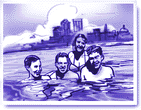 Then the Army began banging on pots, pans and drums. They began
to prod and spook the horses. Arfer barked. The horses whinnied.
(Some vegans in the group protested the use of animals, but declined
to take their place at the pit's edge.) Night was falling and
the sky had gone orange. There was a kind of desperate, restless
energy being stirred up, an end-time keening that stank of celebration
and last kisses and despair. Della said it reminded her of stories
she had heard of the griefstruck dances the wives of drowned sailors
would do as they prepared to throw themselves off the cliffs into
the sea. There was that sense of bravery and loss. The Army chanted
and howled. The horses pissed vigorously into the dust. Little
Arfer lifted his snout to the sky and howled.
Then the Army began banging on pots, pans and drums. They began
to prod and spook the horses. Arfer barked. The horses whinnied.
(Some vegans in the group protested the use of animals, but declined
to take their place at the pit's edge.) Night was falling and
the sky had gone orange. There was a kind of desperate, restless
energy being stirred up, an end-time keening that stank of celebration
and last kisses and despair. Della said it reminded her of stories
she had heard of the griefstruck dances the wives of drowned sailors
would do as they prepared to throw themselves off the cliffs into
the sea. There was that sense of bravery and loss. The Army chanted
and howled. The horses pissed vigorously into the dust. Little
Arfer lifted his snout to the sky and howled.
When the monster struck, it was with suddenness, force, and not
a breath of warning. Suddenly, said a witness, "that little
dog wasn't barking no more." But Tab's senses were sharpened
that evening to superhuman levels.
"I could actually feel it coming," Tab said, "the
way some people say they can feel bad weather."
He already had the trolley moving forward when the creature attacked.
A lot of people had been complaining, back then, that our beloved
trolley was of little use. (Those of you too young to remember
may not realize it only ran a few blocks, rather than traversing
the entire city as it does now.) But Tab and the Army made good
use of it. They had lashed a sort of spearhead to the front--a
hulking piece of sharpened metal from the wreckage--and attached
it to a telephone pole, where it protruded before the trolley
like a lance. And there behind it, like a jousting knight, stood
Tab Whiteman.
Surely you've heard the rest. The unholy gecko lunged, frenzied
with appetite, at the prancing horses. Tab propelled the trolley
at its scaly breast. The spear pierced the reptile's hide, releasing
a stream of cool, green liquid and some partially digested dream-catchers.
Tab himself was only inches from the creature's serrated teeth
(each one gleaming like a sharpened door key) when the trolley
skidded to a halt. The creature clawed the air and made a soft
chirping, like the call of a baby bird. Then it died.
Tab was covered in slime and disintegrating crafts objects. Della
didn't care. She kissed him anyway.
Arfer popped out from the creature's wound and shook himself
off, gooey, but quite intact.
You ignorant kids who ride your skateboards--even if you haven't
paid attention to anything in all your wasted days, surely you've
seen the head of the beast. You can't miss it, stuffed and mounted
on the roof of the International Museum of Wildlife, looming so
large that it casts a shadow across much of the main building,
reducing the cost of air-conditioning it considerably. You may
or may not have heard the story of how the City Council subsequently
voted to pump CAP water into the giant crater, thus creating the
artificial ocean (and employing hundreds of lifeguards). But surely
you've played in the surf. Even if you don't know how much we
sacrificed for you, you've reaped the benefits.
Tab and Della married, of course, and shortly thereafter moved
to the Pacific Northwest, "because being a hero is sort of
exhausting," explained Della, and besides, Tab wanted to
go back to school to become an EMT.
Slowly, over the course of years, the emotional tempo of life
in Tucson settled. We began to feel safe again, as though our
lives would calmly continue, with a smooth and unruffled surface,
forever. The only waves in our lives seemed to be the artificial
ones we kept carefully controlled in the wave pool downtown. Once
again, it seemed that nothing could touch us. Once again, we become
convinced of our invincibility.
Rumors of a giant egg buried beneath the artificial ocean have
never been confirmed.

|
 |





